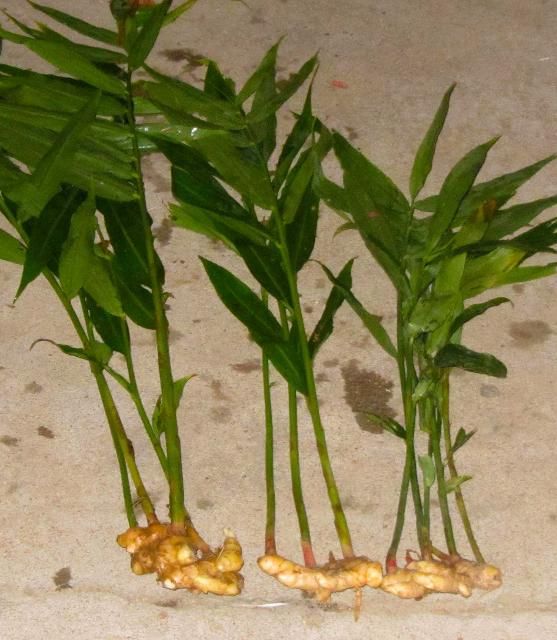Ginger—Zingiber officinale Roscoe1
Ginger is a perennial plant whose underground rhizomes are used as a flavoring agent. It has been grown for centuries in the Caribbean Islands and China where it is used locally for medicine and in cooking. It is marketed in United States mostly in a powdered and candied form. Ginger was grown with some success in experiments at Homestead. When planted in trials at Gainesville, it persisted for 2 years, coming up each spring with the return of warm weather. Gardeners report growing ginger satisfactorily for home use throughout the state.

Credit: James M. Stephens

Credit: Sengai Podhuvan, CC BY-SA 3.0
Description
True ginger is often confused with related plants grown as ornamentals in Florida. Plants of the genus Alpinia growing throughout the state are probably mistaken for ginger more than any other group. There is a slight ginger aroma to the freshly cut rhizomes of the alpinias, and the stalks and leaves are very similar to the true ginger.
True ginger can be distinguished by its shorter stalks, which are 2–3 feet high. Ginger has narrow leaf blades and yellow-green flowers with purple tips growing in dense spikes. It produces plump, strongly aromatic rhizomes.
Culture
Ginger does best in partial to complete shade. In full sun, the leaves are brown-tipped and the plants grow poorly. Most good garden soils, including sands, if sufficiently supplied with nutrients and moisture, are adequate for growing ginger. On rockland such as at Homestead, try growing ginger in a raised box-like structure. It should be 8 inches deep and contain a mixture of sand and cow manure, or other suitable organic mixture.
Ginger is started from rhizome (root) cuttings rather than from seed. It is best to cut the rhizomes into pieces 1 to 1½ inches long, each containing at least one eye. Cut the rhizome pieces a few days ahead of planting to allow the cut surfaces to dry, reducing chances of rotting.
In a well-prepared bed, insert each piece and cover with about 1 inch of soil. Space them 15 inches in the row and 15 inches between the row. Early in the spring is the best time to plant. Undug rhizomes may be divided and replanted. In the Homestead trial, 30 rhizomes were produced per seed piece planted.
Harvesting and Use
To harvest, dig rhizomes in the fall or when the tops have died down. Allow rhizomes to dry in the shade. In Jamaica, the rhizomes are peeled, washed, and sun-dried. Since ginger is a major spice, it has many uses as a food, flavoring, and medicinal product. Candied ginger is peeled, boiled, soaked in syrup, and then rolled in sugar.


